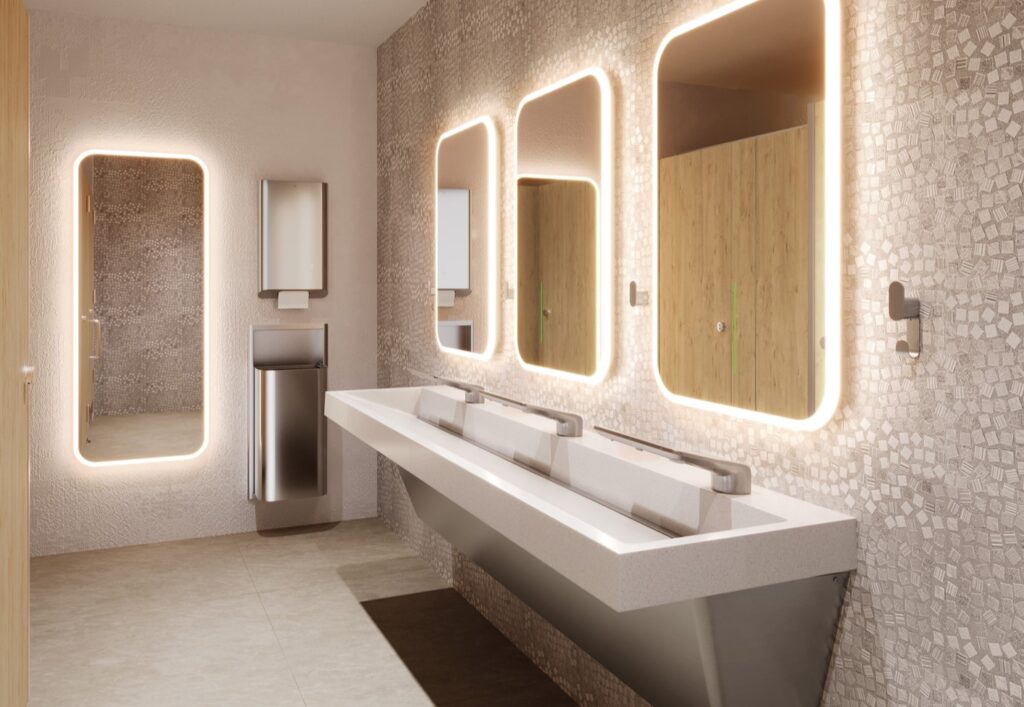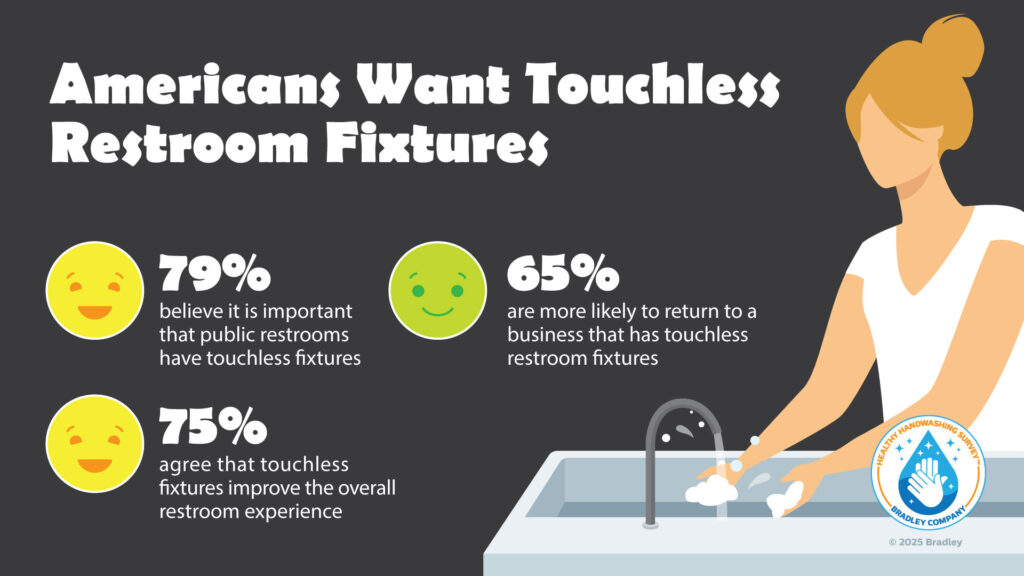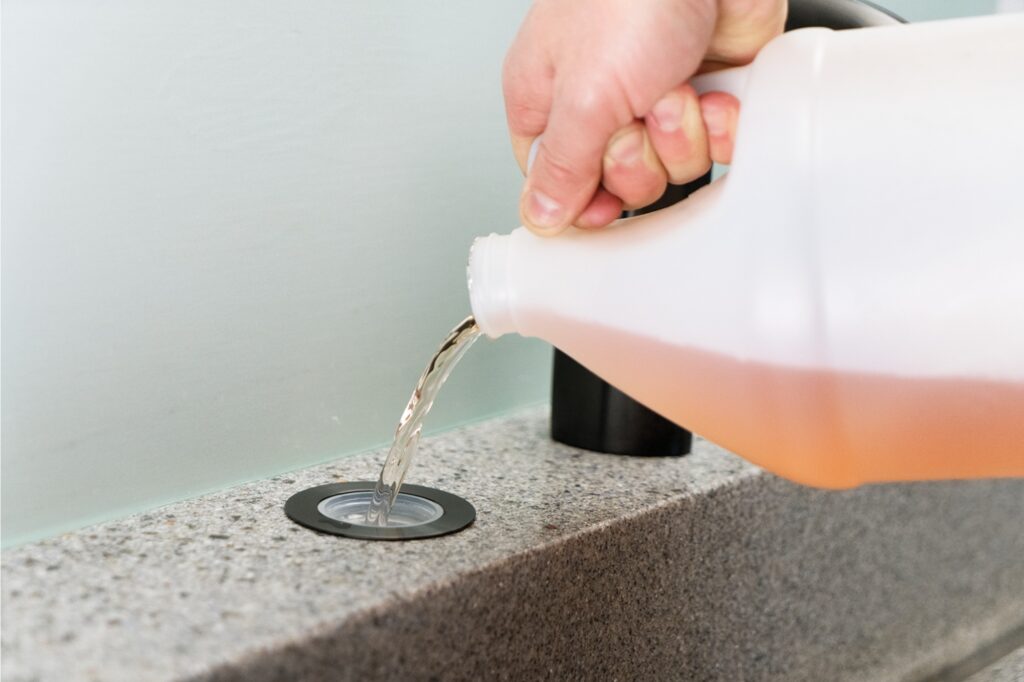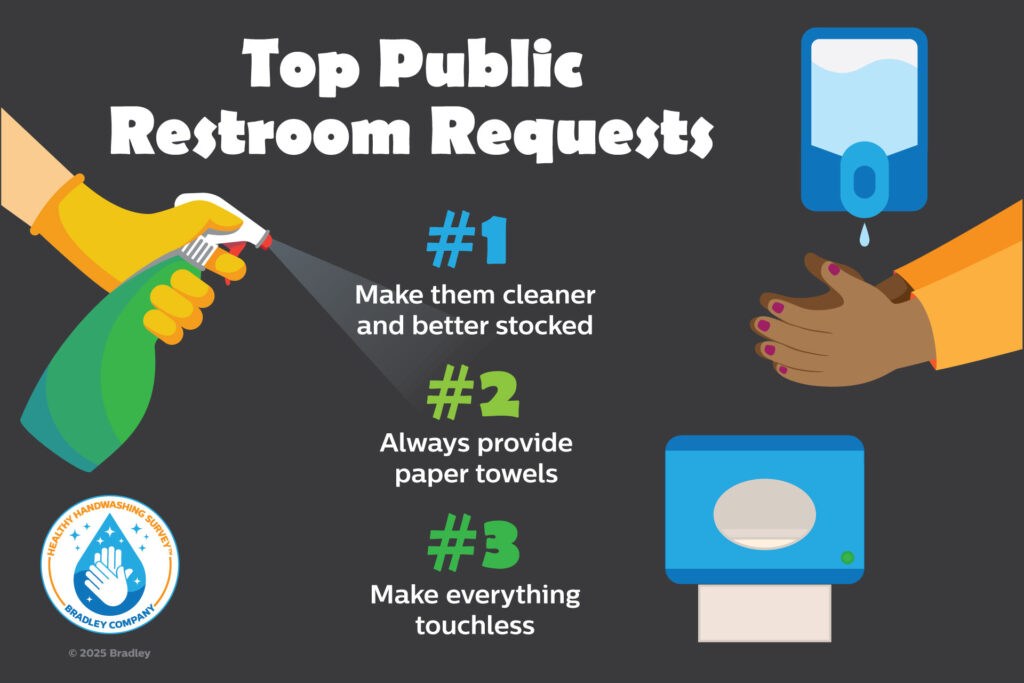Smarter Maintenance, Healthier Restrooms: Survey Insights Fuel New Approaches to Washroom Design
In an era when hygiene expectations are higher than ever, well-maintained commercial restrooms are no longer just a courtesy—they’re essential to public trust, operational efficiency, and brand image. According to Bradley’s 2025 Healthy Handwashing Survey, 71% of Americans say they are more likely to return and even spend more money at a business with a clean and maintained bathroom. That’s a powerful message for facility teams—and one that demands smarter, more streamlined maintenance strategies.

For facilities managers and maintenance staff, washroom challenges are a daily reality: Staffing shortages, increased cleaning demands, and outdated fixtures all compete for attention. But with smarter fixture and design solutions on the market, there’s never been a better time to rethink strategies for commercial washroom maintenance.
The Rise of Touchless Technology
The 2025 survey revealed that nearly 80% of Americans think touchless fixtures are an important feature and believe they improve their overall experience in restrooms. The message is clear: Patrons want fewer germ touchpoints, and facilities managers want fewer surfaces to sanitize.
Touch-free faucets, soap dispensers, and hand dryers not only align with these preferences but also provide user convenience while offering operational advantages. Sensor-activated fixtures help reduce misuse and over-dispensing, which can save water, energy, and soap over time. They also eliminate the need for constant manual surface cleaning of handles, knobs, and levers—a huge time-saver for maintenance crews.

All-in-one handwashing systems take this even further. By integrating soap, water, and drying functions into a single unit, these systems reduce the number of components to clean and maintain, simplifying routine inspections and service. With fewer soap splotches—and water drips and splashes—reaching floors or counters, cleaning becomes more streamlined, minimizing slip hazards and improving the user experience.
Refill Indicators: A Maintenance Game-Changer
One of the most common maintenance pain points in commercial restrooms is managing soap and paper towel refills, especially across large facilities. Running out of supplies doesn’t just inconvenience guests; it reflects poorly on the business and can lead to complaints or negative reviews.
Case in point: 84% of Americans say that an unclean, unstocked, or unpleasant restroom has a negative impact on their overall impression of that business or establishment.
Washroom fixtures and accessories that incorporate smart refill indicators provide a clear, visual, signal to maintenance staff when soap, paper towels, or batteries are running low. This enables staff to prioritize their time and avoid unnecessary checks, creating a more proactive and efficient maintenance workflow. Some soap systems with all-in-one handwashing models even offer top-fill multi-feed capabilities and can serve multiple handwashing stations from a single refill hub—further reducing labor and refill time.

New paper towel dispenser models include an easy-feed feature to prevent jams and torn paper. They also have wall-saving and anti-slam operation to avoid damaging walls when the dispenser is refilled.
Coordinated Design = Less Work, Better Outcomes
An often-overlooked key to restroom efficiency is cohesive design. Coordinated fixtures and accessories don’t just look polished—they also streamline maintenance tasks. When soap dispensers, faucets, dryers, and waste bins are aligned in function and placement, cleaning routines become more efficient, and service procedures are easier to standardize across facilities.
Matching finishes, consistent mounting heights, and smooth and seamless surfaces simplify everything from initial installation to cleaning to long-term upkeep. Some washroom accessory models are available in a selection of modern and resilient finishes that are easy to clean and resistant to fingerprints and corrosion, which is a big bonus when it comes to cleaning. In addition, lavatory systems designed for durability and ease of cleaning—such as solid surface materials or natural quartz—offer seamless, nonporous surfaces that resist staining and bacteria accumulation.
By designing restrooms with maintenance in mind from the start, building owners can reduce downtime, lower cleaning costs, and extend the life of their fixtures.
Meeting Expectations with Smarter Restroom Strategies
With expectations around cleanliness and hygiene only increasing, commercial facilities must take a proactive, tech-forward approach to restroom maintenance. Touchless technology, integrated handwashing systems, smart refill alerts, and cohesive design all contribute to a cleaner, safer environment for users—and a more manageable workload for overworked staff.

Here are a few steps facilities managers can take today to improve maintenance through smarter restroom design:
- Conduct a fixture audit. Identify outdated manual fixtures and prioritize upgrades to touchless models where possible.
- Look for integration opportunities. Consider switching to all-in-one systems to reduce clutter, improve flow, and simplify maintenance.
- Incorporate refill indicators. Upgrade soap dispensers, towel dispensers, and waste systems with LED or digital indicators.
- Choose unified designs. Select coordinated fixtures and lavatory decks that complement each other and are easy to clean and maintain.
- Train and empower staff. Provide maintenance teams with tools and training that help them identify cleaning issues early and reduce reactive service calls.
At the end of the day, restrooms reflect more than just facility upkeep—they reflect a brand’s values and are often judged by their appearance. Businesses that invest in well-designed, well-maintained washrooms show they care about cleanliness, safety, and the people who walk through their doors every day.
Kris Alderson, MBA, LEED AP, is the senior marketing manager for Bradley Company, the 100-year-old global manufacturer of commercial plumbing fixtures, washroom accessories, emergency safety fixtures, and electric tankless water heaters, now a division of Watts Water Technologies. For more information on the Healthy Handwashing Survey, check out bradleycorp.com/handwashing. All images courtesy of Bradley.
The post Smarter Maintenance, Healthier Restrooms: Survey Insights Fuel New Approaches to Washroom Design appeared first on Facilities Management Advisor.

